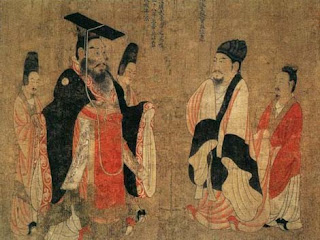China: A Brief History of the Sui Dynasty
 |
| Yang Guang (left in black) depicted as Emperor of Sui |
Yang Jian Unites North and South China
Following a chaotic period of roughly 3 centuries in which the Northern and the Southern Dynasties were constantly at war, Yang Jian, a nobleman who was the prime minister under the previous emperor, united the political and military powers and through his defeats of the other dynasties was able to finally unite both north and south China. Although he established the Sui Dynasty in 581 A. D., it wasn’t until the defeat of the Chen Dynasty in 589 that the whole country was finally united. “As a result of the unification, the society became stable and peaceful which encouraged economical and political development” (Sui Dynasty, n.d., para. 4)
Examination System Established as Way of Electing Officials
Upon unifying the country, Yang established the new capital at Chang’an, the modern day city of Xi’an in Shaanxi Province. In order to enable more talent to be represented in the government, the new emperor abolished the system used by the Northern Zhou where government officials were appointed by prefects. In the new system, potential government officials were required to take an examination. Those who took the examinations were chosen by the people in their local areas. Anyone could be chosen regardless of family or class. Whereas the previous system was based more on popularity, the new one was based on intellect.
New Tax Codes Improve Farmers Livelihood
During his reign, the economy also improved due to the reforms he had introduced in the areas of farming and taxation. The land was distributed equally among the farmers, and the tax code was rewritten in such a way that crop yields increased while lowering the taxes required to be paid. This combination of higher yields and overall lower tax rates led to an increase in government revenue without driving the farmers into poverty. Emperor Yang also called for the construction of a canal, which would connect the northern and southern provinces. This canal allowed for the exchange of commerce, ideas, and cultural ideas between the two areas of the country.
New System of Government Established
In addition to improving the selection process of political officials, Yang also reorganized the government into a more precise political machine. He engineered a system that would be known as the Three Cabinets and Six Departments System. The three cabinets were: the legislative bureau which was the policy making organization; the chancellery which was in charge of deliberation; and the executive branch which was in control of administration. The six departments were divided into personnel, revenue, rites, war, justice and works which were responsible for daily affairs. According to the website Warrior Tours “by doing so, he redressed the overfull organization abuses, improved political corruption, and saved government expenditures” (Sui Dynasty (581-618), n.d., para. 5).
The End of the Dynasty
Despite the reforms and improvements implemented by Emperor Yang, the Sui Dynasty would soon come to an end not long after his son began to reign. Sui Yangdi was a tyrant who began his political career by murdering his father and brothers. He then set out to build a series of expensive projects that would financially break the country. In an attempt to appease his ego, he set off on a series of military campaigns to conquer the neighboring countries. After an unsuccessful attempt to conquer what today is known as Korea, Sui Yangdi was assassinated upon his return to the capital. Shortly after this the Sui Dynasty came to an end.
References
Sui Dynasty. (n.d.). Travel China Guide website. Retrieved June 3, 2013, from http://www.travelchinaguide.com/intro/history/sui
Sui Dynasty (581-618). (n.d.). Warrior Tours website. Retrieved June 20, 2013, from www.warriortours.com/intro/history/sui




Comments
Post a Comment